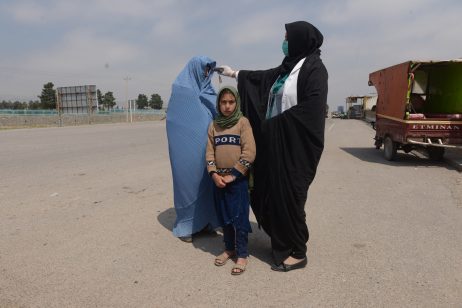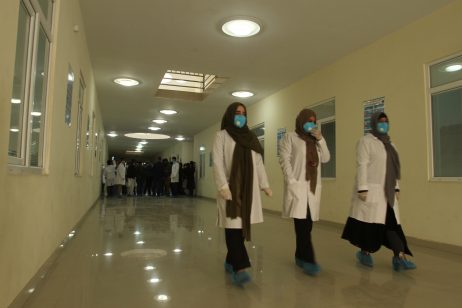By Mohammad Aref Karim and Mariam Alimi
An employee of the Ministry of Health measures the temperature of an internally displaced family outside of Herat. Despite the pandemic, violence has not come to a halt and forced over 75,000 people to flee their homes since January 2020. They are now particularly vulnerable.
A group of young female doctors, in the district hospital of Ghoryani in Herat, near the Iranian border. Hundreds of thousands of Afghans have returned from Iran since February 2020, making Herat the country’s first COVID-19 hotspot.Credit: FES/ Mohammad Aref Karim
Health officials, local authorities, and volunteers are disinfecting rickshaws, buses, and streets to prevent the virus from spreading further in Herat.Credit: FES/ Mohammad Aref Karim
45-year-old Muhammad sits on the sidewalk in Herat. Since the outbreak of the pandemic, there are no customers for shoe repairs and his situation has deteriorated significantly.
Many shops in Herat city center were closed by authorities to contain the spread of the virus. Yet as soon as the police officers are gone, most of them reopen quickly.Credit: FES/ Mohammad Aref Karim
Despite curfews and warnings from the authorities, there is still no capacity to enforce a lockdown effectively. Hence, market activity in Herat’s shopping street Darb-e-Qandahar continued almost undisturbed.Credit: FES/ Mohammad Aref Karim
On their way home to Karukh, these villagers complain about increasing food prices in the bazaar in Herat. Border closures and reduced imports from Central and South Asia contributed to this situation, as did corruption and mismanagement.Credit: FES/ Mohammad Aref Karim
A farmer in Guzara, south of Herat, cultivates his land, seemingly unaffected by the crisis. But the many travel restrictions keep him and his family from selling vegetables in the city markets.Credit: FES/ Mohammad Aref Karim
55-year-old Abdul Zahir is disabled and lives with seven family members on the outskirts of Herat. He sold drinks and phone cards before the pandemic; the family now faces social decline and the risk of homelessness.Credit: FES/ Mohammad Aref Karim
A domestic worker with three small children receives alms in front of a restaurant in Herat. The share of Afghans living below the poverty line could now rise to more than 60 percent.Credit: FES/ Mohammad Aref Karim
Many Kabul residents like this woman seek medical assistance at the Afghan-Japanese hospital. Trust in health institutions has declined in the past weeks as most of them are ill-equipped and understaffed.Credit: FES/ Mariam Alimi
Doctors at the Afghan-Japanese hospital inspect test results. According to the Ministry of Health, only 2,000 of up to 20,000 daily arriving samples can be tested in due time.Credit: FES/ Mariam Alimi
Accommodation in tight quarters and weak immune systems make members of the army particularly vulnerable. 25-year-old officer Shah Aqha from northern Sar-e- Pul province is waiting in quarantine for his test result.Credit: FES/ Mariam Alimi
Many patients criticize that they never see medical personnel and receive even their food only through metal-grilled windows. One reason: more than 850 health workers have contracted the virus due to a lack of protective equipment.Credit: FES/ Mariam Alimi
The chronic shortage of staff leaves its mark. For three months, health worker Juma Khan has not seen his family due to the risk of infection and the high workload.Credit: FES/ Mariam Alimi
Government agencies, international organizations, and civil society try to prevent further spread through education. Dozens of mobile antibacterial sinks help Kabul residents comply with hygiene regulations.Credit: FES/ Mariam Alimi
Anyone on the streets of Kabul without a permit could be stopped and sent back by the police. Implementing these tight rules has been nearly impossible for authorities.Credit: FES/ Mariam Alimi
39-year-old day laborer Mohammad Agha has to provide for a large family and earned some 2 euros a day before the crisis. He is certain: “If the virus doesn’t kill us, poverty will.”Credit: FES/ Mariam Alimi
8-year-old Ahmad is one of hundreds of thousands of Afghan children who contribute to or earn the family’s income. Despite the lockdown in Kabul, he wants to continue selling chocolate to provide for his family.Credit: FES/ Mariam Alimi
As in other countries in Asia and all around the world, COVID-19 has become a nationwide challenge for Afghanistan. Decades of war have wreaked havoc on a health system that is unable to contain or adequately monitor the spread of the virus.
Effective treatment is additionally complicated by ill-prepared and ill-equipped facilities – symbolized by the alarming number of infected health workers, over 850 as of June 4, 2020. Preventive measures such as a “lockdown” of urban areas were initiated in late March. But such efforts have not been effective in containing the spread, while some have further increased socioeconomic hardships in a highly informal economy.
To add insult to injury, many of Afghanistan’s neighbors have temporarily closed their borders and reduced supplies, causing shortages and a spike in food prices in the Afghan markets. Finally, the failure of all conflict parties to agree on a nationwide humanitarian ceasefire will continue to prevent decision makers from joint and decisive action to cope with this existential crisis.
With the support of the Friedrich-Ebert-Stiftung Afghanistan, photographers Mohammad Aref Karim and Mariam Alimi explored everyday life in Herat and Kabul. The aim of the project is to shed a light particularly on the deep socioeconomic impact of the pandemic on Afghan lives and the country’s prospect for peace. The Friedrich-Ebert-Stiftung (FES) is the oldest political foundation in Germany with a rich tradition dating back to its foundation in 1925. Through more than 100 offices worldwide, FES campaigns for the core ideas and values of social democracy: freedom, justice and solidarity.


No comments:
Post a Comment